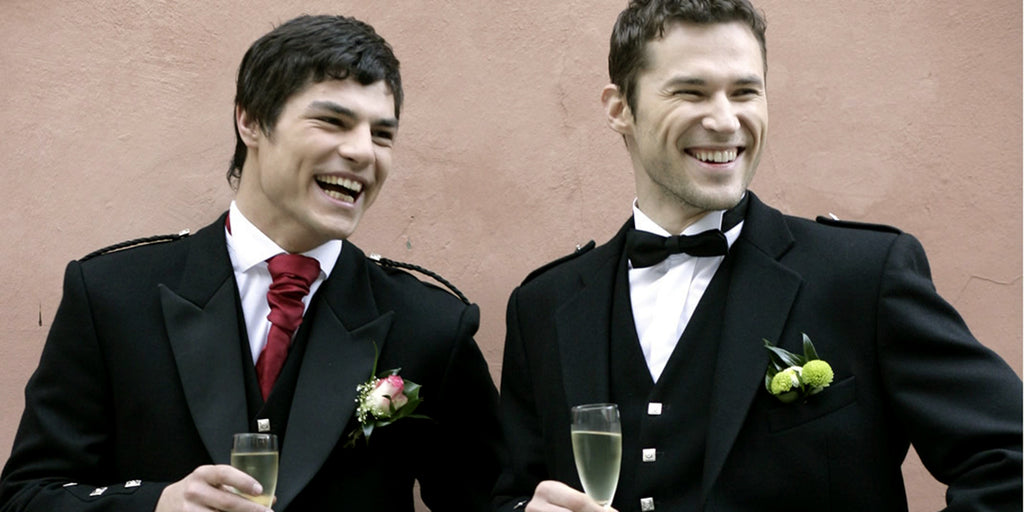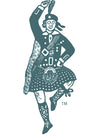Scottish weddings can vary from simple elopements in the glorious Highlands, to formal ceremonies in castles and hotels, and to more casual events in fun locations. They don’t have to be held in Scotland – many couples with Scottish heritage will have a Scottish wedding wherever they happen to live.
But wherever they’re held they will usually all have one thing in common. There will be kilts. The groom, groomsmen, and many of the male guests will likely be wearing tartan kilts. It’s one of the many Scottish Traditions that kilts are worn with pride at formal gatherings. You can expect to see everything from a casual fashion kilt worn to a full traditional kilt outfit. And very smart they will look too.
But that’s not all. When planning their Scottish wedding, many couples will include a piper playing the bagpipes. And there may also be some Celtic traditions such as drinking from a quaich and a handfasting ritual.
In this blog post we take a look at some of the key elements of a traditional Scottish wedding. So, if you get invited to a wedding in Scotland you have an idea of what to expect. We can also offer advice on buying or hiring a kilt outfit if you need one for a wedding.
Photo Credit: Brian Hawkin's Scottish wedding ceremony - drinking from the quaich. https://humanistbrian.com/
SCOTTISH WEDDING CEREMONY TRADITION
There are a few unique wedding traditions that you might come across different Scottish regions. Here are a few:
-
Sixpence: In Aberdeenshire and Angus an old sixpence (or a modern 5p) coin is placed in the bride's shoe for luck
-
Feet washing: In Angus, Dundee and Fife the bride’s feet were traditionally washed before the wedding by a married relative such as an aunt or sister. This was to symbolise purity.
-
Oathing stone: Some areas in Scotland still include an oathing stone in the ceremony. Traditionally, a couple would swear an oath over water or over a stone. Nowadays, some couples choose to join hands on a pebble as they say their vows.
-
Pinning the tartan: This would happen immediately after the couple are declared married to symbolise that each spouse has been welcomed into the other’s family. Usually a rosette or crest is pinned to each spouse’s tartan sash by a member of the other’s family. Highland Store has a lovey range of kilt pins that would be perfect for this ritual.
WEARING KILTS AT SCOTTISH WEDDINGS

The one obvious and unique element at a Scottish wedding is that the groom and male guests will wear traditional Scottish kilts.
If the groom is Scottish he and his male relatives and friends will wear the tartan of their clans. Did you know that there are thousands of distinct tartans and more are being designed each year? If you’re interested in the history of tartans and how the kilt came to be you can find out more in our blog post “The history of tartan”
Guests may also wish to join in to complete their experience of a Scottish wedding. If you’ve been invited to a Scottish wedding Highland Store can help you via our kilt store online as well as our retail store in central London.
Even if you don’t have a family or clan tartan anyone can wear what is called an ‘open tartan’. One of the most popular and well known examples is Black Watch tartan. It has an interesting history which you can read about here.
If you have Scottish heritage and would like to invest in a kilt of your own, we do offer a ready-to-wear range. Our team can also create a made-to-measure kilt.
Our blog post How to choose and wear a kilt is a useful guide. It provides information on everything you need to know about kilts, including all the accessories you might need, as well as the right order to put on your kilt outfit.
You can see our great kilt accessories range on our website – including such items as hose (socks) and flashes, traditional ghillie brogues, our large range of day, dress and semi-dress sporrans, as well as kilt pins and Celtic decorated cufflinks. We also stock special ceremonial daggers called the sgian dubh, which are worn tucked into the hose.
THE SKIRL OF THE BAGPIPES

The bagpipes are such an iconic symbol of Scotland that it’s no surprise that they feature prominently in many Scottish weddings. A piper in full Highland dress playing the bagpipes is a stirring sight. And the skirl of the bagpipes playing traditional Scottish tunes adds another dimension to the atmosphere.
You can expect a piper to be playing as the guests assemble at the venue and then for the arrival of the bridal party and as the couple make their exit.
A piper may also play during the drinks reception and then again as the couple take their seats at their table. Pipers may also toast the couple with a dram of Scotch before playing themselves out of the room. They are often available to have photos taken with guests.
DRINKING FROM THE QUAICH

The quaich – sometimes called a loving cup – is unique to Scotland and is linked to a long-established tradition of hospitality. It is generally made from wood, pewter or silver and comprises a shallow bowl and two handles.
The word ‘quaich’ derives from the Scottish Gaelic word for cup – ‘cuach’. It you’re wondering how to pronounce it – it’s ‘quake’ rather than ‘quiche’.
The story goes that back in the time or the powerful Scottish clans, if you share a drink from a cup like this with somebody you can’t do harm or injury to the other because it takes both hands. This was important back in the day when clans weren’t always at peace with each other. Clan chieftans would take turns to drink whisky from a quaich to celebrate a bond of friendship and peace.
In Scottish weddings a quaich ceremony is included after the exchange of vows and rings and when the marriage schedule has been signed. This lovely ritual symbolises the couple’s shared love and commitment.
The cup can be filled with a drink of choice (usually Scotch) and the couple both hold the cup as they take turns to sip from it. Couples often also use the quaich to make their first toast together at the wedding reception.
Quaichs can be plain or feature decorative Celtic symbols. The couple’s names and the wedding date can also be engraved on the quaich as a keepsake. Highland Store offers a range of beautiful engraved pewter quaichs at our store opposite the British Museum in London. Use our contact us page for full shop details if you would like to order a quaich.
THE ANCIENT RITUAL OF HANDFASTING
The custom of handfasting to symbolise marriage extends way back into the Middle Ages and is a popular feature of many modern Scottish weddings.
If you watch the clip above from the movie Braveheart you can see they use a piece of rough tartan to wrap around the couple’s joined hands. And if you’re a Game of Thrones fan you’ll also have seen handfasting rituals performed in many of the weddings depicted.
For modern Scottish weddings, the ritual of handfasting usually comes towards the end of the wedding ceremony. You can expect to see the celebrant or marriage witnesses wrap ribbons, scarves, cords, or pieces of tartan around the couple’s hands.
When the couple withdraw their hands and pull on the ribbons or cords, they are left with a knot, which is where we get the phrase ‘tying the knot’ from.
ACCESSORIES FOR A SCOTTISH WEDDING
If you're going to enter into the full spirit of a traditional Scottish wedding, why not consider adding some Scottish and Celtic-themed accessories? These also make great wedding gifts.
Highland Store offers a selection of pewter drinks flasks decorated with Celtic engravings in-store. Use our contact us page for full shop details and if you’d like to order one. And if the Scottish wedding you're attending is outside, how about treating yourself to a lovely tartan wool ruana, shawl or scarf?
Our fabulous range of warm tartan blankets and throws may also come in handy.



